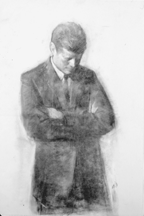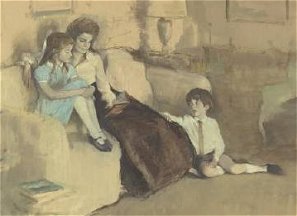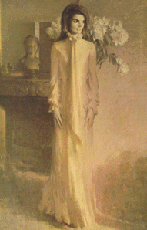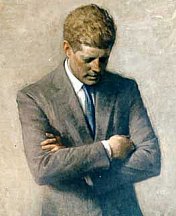
and DANTON BURROUGHS Present |

and DANTON BURROUGHS Present |
|
A Life's Journey Through the World's Print Media 1875-1950 A Collection of newspaper clippings and articles from Chicago to Tarzana ~ around the world ~ and back to Encino/Tarzana |

 |
December 1967 An urbane man of letters looks back nostalgically at the Complete Works of Edgar Rice Burroughs and concludes that for sheer daydreaming the Best Man is still the Ape Man. |
There are so many things the people who take polls never get around to asking. Fascinated as we all are to know what our countrymen think of great issues (approving, disapproving, "don't-knowing," with that same shrew intelligence which mad a primeval wilderness bloom with Howard Johnson signs), the pollsters never get around to asking the sort of interesting personal questions our new-Athenians might be able to answer knowledgeably. For instance, how many adults have an adventure serial running in their heads? How many consciously daydream, turning on a story in which the dreamer ceases to be an employee of I.B.M and becomes a handsome demigod moving through splendid palaces, saving maidens from monsters (or monsters from maidens: this is a jaded time). Most children tell themselves stories in which they figure as powerful figures, enjoying the pleasures not only of the adult world as they conceive it but of a world of wonders unlike dull reality. Although this sort of Mittyesque daydreaming is supposed to cease in maturity, I suggest that more adults than we suspect are bemusedly wandering about with a full Technicolor extravaganza going on in their heads. Clad in tights, rapier in hand, the daydreamers drive their Jaguars at fantastic speeds through a glittering world of adoring love objects, mingling anachronistic historic worlds with science fiction. "Captain, the time-warp's been closed! We are now trapped in a parallel world, inhabited entirely by women with three breasts." Though from what we can gather about these imaginary worlds, they tend to be more Adlerian than Freudian: The motor drive is the desire not for sex (other briefer fantasies take care of that) but for power, for the ability to dominate one's environment through physical strength. I sate all this with perfect authority because I have just finished rereading several books by the master of American daydreamers, Edgar Rice Burroughs, whose works today, as anyone who goes into a drugstore or looks at a newsstand can see, have suddenly returned to great popularity.
When I was growing up, I read all twenty-three Tarzan® books, as well as the ten Mars books. My own inner storytelling mechanism was vivid. At any one time, I had at least three serials going as well as a number of old faithful reruns. I used Burroughs as a a source of raw material. When he went to the center of the earth a la Jules Verne (much too fancy a writer for one's taste), I immediately worked up a thirteen-part series, with myself as lead, and various friends as guest stars. Sometimes I used the master's material, but more often I adapted it freely to suit myself. One's daydreams tended to be Tarzanish pre-puberty (physical strength and freedom) and Martian post-puberty (exotic worlds and subtle combinazones to be worked out). After adolescence, if one's life is sufficiently interesting, the desire to tell oneself stories diminishes. My last serial ran into sponsor trouble when I was in the Second World War and was never renewed.
Until recently I assumed that most people were like myself: day-dreaming ceases when the world becomes interesting and reasonably manageable. Now I am not so certain. Pondering the life and success of Burroughs leads one to believe that a good many people find their lives so unsatisfactory that they go right on year after year telling themselves stories in which they are able to dominate their environment in a way that is not possible in this over organized society.
"Most of the stories I wrote were the stories I told myself just before I went to sleep," said Edgar Rice Burroughs, describing his own work. He is a fascinating figure to contemplate, an archetype American dreamer. Born 1875, in Chicago, he was a drifter until he was thirty-six. Briefly, he served in the U.S. Cavalry, then he was a gold miner in Oregon, a cowboy in Idaho, a railroad policeman in Salt Lake City; he attempted several businesses that failed. He was perfectly in the old-American grain: The man who could take on almost any job, who liked to keep moving, who tried to get rich quick, but could never pull it off. And while he was drifting through the unsatisfactory real world, he consoled himself with an inner world where he was strong and handsome, adored by beautiful women and worshiped by exotic races. Burroughs might have gone to his death, an unknown daydreamer, if he had not started reading pulp fiction. He needed raw material for his own inner serials and once he had used up his favorite source, Rider Haggard, he turned to the magazines. He was appalled at how poor the stories were. They did not compare to his own imaginings. He was like a lover of pornography who, unable to find works which excite him, turns to writing them. Burroughs promptly wrote a serial about Mars and sold it to Munsey's. His fellow daydreamers recognized a master. In 1914 he published his first book, Tarzan of the Apes (Rousseau's noble savage reborn in Africa), and history was made. To date the Tarzan books have sold over twenty-five million copies in fifty-six languages. There is hardly an American male of my generation who has not at one time or another tried to master the victory cry of the great ape as it once bellowed forth from the androgynous chest of Johnny Weissmuller, while a thousand arms and legs were broken by attempts to swing from tree to tree in the backyards of the republic. Between 1914 and his death in 1950, Burroughs, the squire of Tarzana, California (a prophet honored by his own land), produced over sixty books, while enjoying the unique status of being the first American writer to be a corporation. Burroughs is said to have been a pleasant, unpretentious man who liked to ride and play golf. Not one to disturb his on unconscious with reality, he never set foot in Africa.
With a sense of recapturing childhood, I have just reread several Tarzan books. It is fascinating to see how much one recalls after a quarter century. At times the sense of deja vu is overpowering. It is equally interesting to discover that one's memories of Tarzan of the Apes are mostly action scenes. The plot had slipped one's mind. It is a lot of plot, too. The beginning is worthy of Conrad. "I had this story from one who had no business to tell it to me, or to any other. I may credit the seductive influence of an old vintage upon the narrator for the beginning of it, and my own skeptical incredulity during the days that followed for the balance of the strange tale." It is 1888. The young Lord and Lady Greystoke are involved in a ship mutiny ("there was in the whole atmosphere of the craft that undefinable something which presages disaster"). They are put ashore on the west coast of Africa. They build a tree house. Here Burroughs is at his best. He tells you the size of the logs, the way to hang a door when you have no hinges, the problems of roofing. All his books are filled with interesting details on how things are made. The Greystokes have a child. They die. The "man-child" is taken up by Kala, a Great Ape, who brings him up as a member of her tribe of apes. Burroughs is a rather vague anthropologist. His apes have a language. They are carnivorous. They can, he suspects, mate with human beings. Tarzan grows up as an ape; he kills his first lion (with a full nelson); he teaches himself to read and write English by studying some books found in the cabin. The method he used, sad to say, is the currently fashionable "look-see." Though he can read and write, he cannot speak any language except that of the apes. He gets on well with the animal kingdom, with Tantor the elephant, Ska the vulture, Numa the lion (Kipling has added his grist to the Burroughs dream mill). Then white people arrive: Professor Archimedes Q. Porter and his daughter Jane. Also, a Frenchman named D'Arnot who teaches Tarzan to speak French, which is confusing. By coincidence , Jane's suitor is the current Lord Greystoke, who thinks the Greystoke baby is dead. Tarzan saves Jane from an ape. Then he puts on clothes and goes to Paris where he drinks absinthe. Next stop, America. In Wisconsin, he saves Jane Porter from a forest fire; then he nobly gives her up to Lord Greystoke, not revealing the fact that he is the real Lord Greystoke. Fortunately in the next volume, The Return of Tarzan, he marries Jane and they live happily ever after in Africa, raising a son John, who in turn grows up and has a son. Yet even as a grandfather, Tarzan continues to have adventures with people a foot high, with descendants of Atlantis, with the heirs of a Roman legion who think that Rome is still a success. All through these stories one gets the sense that one is daydreaming, too. Episode follows episode with no particular urgency. Tarzan is always knocked on the head and taken captive; he always escapes; there is always a beautiful princess or high priestess who loves him and assists him; there is always a loyal friend who fights beside him, very much in the Queequeg tradition which Leslie Fielder assures us is the urning in the fuel supply of the American psyche. But no matter how difficult the adventure, Tarzan, clad only in a loincloth with no weapon save a knife (the style is contagious), wins against all odds and returns to his shadowy wife.
These books are clearly for men. I have yet to meet a woman who found Tarzan interesting: no identification, as they say in series-land.
Stylistically, Burroughs is -- how shall I put it? -- uneven. He has moments of ornate pomp, when the darkness is "Cimmerian"; of redundancy, "she was hideous and ugly"; of extraordinary dialogue: "Name of a name," shrieked Rokoff. "Pig, but you shall die for this!" Or Lady Greystoke to Lord G.: "Duty is duty, my husband, and no amount of sophistries may change it. I would be a poor wife for an English lord were I to be responsible for his shirking a plain duty." Or the grandchild: "Muvver," he cried, "Dackie doe? Dackie Doe?" "Let him come along," urged Tarzan. "Dare!" exclaimed the boy turning triumphantly upon the governess, "Dackie do doe yalk!" Burroughs' use of coincidence is shameless even for a pulp writer. In one book he has three sets of characters shipwrecked at exactly the same point on the shore of Africa. Even Burroughs finds this a bit much. "Could it be possible [muses Tarzan] that fate had thrown him up at the very threshold of his own beloved jungle?" It was possible, of course; anything can happen in a daydream.
Though Burroughs is innocent of literature and cannot reproduce human speech, he does have a gift very few writers of any kind possess: he can describe action vividly. I give away no trade secrets when I say that this is as difficult for a Tolstoi as it is for a Burroughs (even William). Because it is so hard, the craftier contemporary novelists usually prefer to tell their stories in the first person, which is simply writing dialogue. In character, as it were, the writer settles for an impression of what happened rather than creating eh sense of a happening. Tarzan in action is excellent.
There is something basic in the appeal of the 1914 Tarzan which makes me think that he can still hold his own as a daydream figure, despite the sophisticated challenge of his two contemporary competitors, Ian Fleming and Mickey Spillane. For most adults, Tarzan (and John Carter of Mars) can hardly compete wit the conspicuous consumer consumption of James Bond or the sickly violence of Mike Hammer, but for children and adolescents, the old appeal continues. All of us need the idea of a world alternative to this one. From Plato's Republic to Opar to Bond-land, at every level, the human imagination has tried to imagine something better for itself than the existing society. Man left Eden when we got up off all fours, endowing most of his descendants with nostalgia as well as chronic backache. In its naive way, the Tarzan legend returns us to that Eden where, free of clothes and the inhibitions of an oppressive society, a man can achieve his continuing need, which is, as William Faulkner put it in his high Confederate style, to prevail as well as endure. The current fascination with L.S.D. and non-addictive drugs -- not to mention alcoholism -- is all part of a general sense of frustration and boredom. The individual's desire to dominate his environment is not a desirable trait in a society which every day grows more and more confining. Since there are few legitimate releases for the average man, he must take to daydreaming. James Bond, Mike Hammer and Tarzan are all dream-selves, and the aim of each is to establish personal primacy in a world which in reality diminishes the individual. Among adults, increasing popularity of these lively inferior fictions strikes me as a most significant (and unbearably sad) phenomenon.
~ Tarzan® Painting by Aaron Shickler
| Portrait painter Aaron Shikler was born in Brooklyn,
New York, in 1922. He studied at the Barnes Foundation, Merion, Pennsylvania,
and received B.A. and M.A. degrees from the Tyler School of Art, Temple
University, Philadelphia. He also studied at the American University, Shrivenham,
England, and the Hans Hoffman School, New York City. Shikler became an
Associate of the National Academy of Design, New York City, in 1962, an
Academician in 1965. ~ AskArt.com
Probably Shickler's most famous work is the 1970 charcoal-on-paper study for an official White House likeness of John F. Kennedy. "I tried to capture the Kennedy of the days of the Cuban missile crisis," the artist explained. The Kennedys shared a passion for the arts throughout their lives and formed relationships with many artists. Aaron Shickler was initially engaged by Jacqueline Kennedy to paint portraits of her children in 1968: Portrait Of Jacqueline Kennedy With Caroline And John Jr. and John And Caroline Reading, A Study. These paintings were done in the living room of her mother's Manhattan apartment. Subsequently, she asked him to paint her official White House portrait
as well as that of President Kennedy. He also painted the official White
House portrait of first lady Nancy Reagan.
|




| Description: President John F. Kennedy brought a strong sense of history and culture to the White House. Under his direction, Congress designated all White House interiors worthy of preservation and interpretation and placed the National Park Service in charge of the house’s maintenance. Before he was assassinated on November 22, 1963, President Kennedy expanded the presidential and first lady portrait collection and worked to connect the White House past with its present through its historic décor. |
WEB REFS
ERBzine Silver Screen
Guide
e-Text Editions
of the ERB Novels
ERB
and the Press
A Life's Journey Through the Newspapers of the World: 1875-1950

Send
all correspondence to
WEBMASTER:
BILL HILLMAN
ERB
Text, ERB Images and Tarzan® are ©Edgar
Rice Burroughs, Inc. - All Rights Reserved.
Trademarks
JOHN CARTER, WARLORD OF MARS ~ BARSOOM ~ TARZAN
and
all associated characters and their distinctive likenesses are owned by
ERB, Inc.
No
part of this Web site may be reproduced without permission.